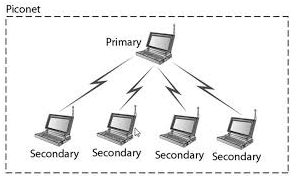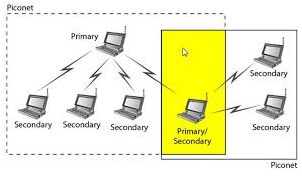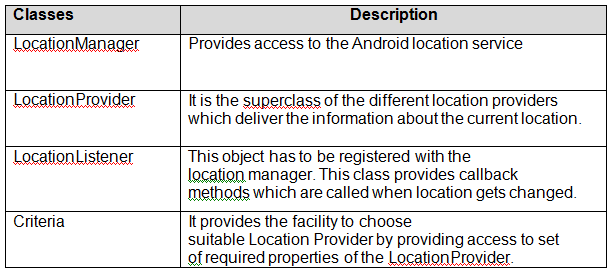Q.8) Write short notes (Any Four) [20]
a) Bluetooth.
b) Palm OS.
c) Android Database.
d) Context aware computing.
e) Location finding process. a) BLUETOOTHAns. Bluetooth technology is the implementation of a protocol defined by the IEEE 802.15 standard. It is a wireless LAN technology. By using this technology you can connect different devices such as telephones, notebooks, desktop computers, laptop, cameras, printers and many more.
A Bluetooth network is an ad hoc network, which means that the network is formed without an access point. Bluetooth network works in small area and we cannot connect lots of devices simultaneously.
ArchitectureBluetooth defines two types of networks: piconet and scatternet.
PiconetA Bluetooth network is called a piconet. A piconet can have maximum eight stations, one of which is called the primary and the remaining are called secondary
In piconet there is only one primary station available. The communication between the primary and the secondary can be one-to-one or one-to-many.
 Scatternet
ScatternetScatternet is the combination of piconet. A secondary station in one piconet can be worked as the primary in another piconet. A secondary station receives messages from the primary in the first piconet and sending them to secondary in the second piconet so works as primary for second piconet.
 b) Palm OSAns.
b) Palm OSAns. Palm OS is a mobile operating system and it developed by Palm, Inc.It was used in personal digital assistants (PDAs) .It supports touch screen-based graphical user interface.Later versions of the OS have been extended to support smartphones.Palm OS is written in c++.
In Palm OS a user can uses one application at a time
The key features of the Palm OS are: - CommonGUI set.
- Simple, single-tasking environment.
- Monochrome or color screens with resolutions up to 480x320 pixel
- It supports Handwriting recognition input system called Graffiti 2
- Sound playback and record capabilities
- Simple security model: Device can be locked by user defined password.
- TCP/IP network access
- Serial port/USB, infrared, Bluetooth and Wi-Fi connections
- You can extend memory by using memory card support
- Defined standard data format for applications.
c) Android Database. Ans. SQLite is the default database of Android. SQLite is a perfect choice for creating databases on mobile operating systems because is a lightweight database and occupies a small amount of disk storage and memory at run time. The android.database.sqlite package contains the SQLite specific classes.
In Android operating system, there is no built in interface or application that directly manage or create the database. So you have to create database by coding only.
There are two important classes in SQLite database
-
SQLiteOpenHelper-
SQLiteDatabaseFor creating the database the first step is to create a class that inherits from SQLiteOpenHelper class. This class provides two you two methods for creating and upgrading the database:
1. onCreate(SQLiteDatabase db): This method is invoked when the database is created.
2. onUpgrade(SQLiteDatabse db, int oldVersion, int newVersion): This method is invoked when we alter ,drop or creating the new table.
SQLiteDatabase class provides methods to open, query, update and close the database.It also provides the execSQL() method, which allows to execute an SQL statement directly.
d) Context aware computingAns. Context-aware computing or pervasive computing is a mobile computing mechanism in which software applications can discover and take advantage of contextual information such as user location, time of day, nearby users, devices, and user activity.
Some other definitions are:
What it is... Context-aware computing is:
“software that examines and reacts to an individual’s changing context.”
By- Schilit, Adams, & Want 1994
“aware of its user’s state and surroundings , and help it adaptits behavior”
By- Satyanarayanan 2000
What is context?
“any information that can be used to characterize the situation of an entity.”
(Dey et al., 2000)
Classification of context- Identity (Who)
- Activity (What)
- Time (When)
- Location (Where)
Application of contextDey proposes three basic functions that should be implemented by any context-aware application.
- Presentation of information and services.
Presentation of information and services means that either it present context information to the user, or use context help the user for selections of actions.
Examples: According to the context, it provides the user’s location on the map and nearby sites of interest.
- Automatic execution of services.
Examples: A navigation system that provides you direction when the user misses a turn.
- Storage (and retrieval) of context information.
Example: A context aware system that provides the data related to meeting as who was there, when the meeting occurred and where it was located.
Context-aware applications- Context-aware browser (CAB)
- Context-based workplace awareness
- ConaMSN: A context-aware messenger
- InCarMusic: Context-aware music recommendations
Security and privacy issues There are two main security concerns with context-aware systems.
- Ensuring privacy of location and identity information.
- Ensuring secure communications.
e.)Location finding process. Ans. Geolocation is the mechanism to identify the geographic location of an object, such as mobile phone or Internet-connected laptop/desktop.
Geocoding and Reverse geocoding are two techniques that help to find the location on the map.
By using geocoding process you can convert address into geographic coordinates called as latitude and longitude.
Reverse geocoding is the process of converting geographic coordinates into a human-readable address.
For accessing the location based services Android provide different classes that are available in android. location.
The different classes are as follows:

You can initialize LocationManager object according to given below code.
LocationManager service = (LocationManager)getSystemService(LOCATION_SERVICE);